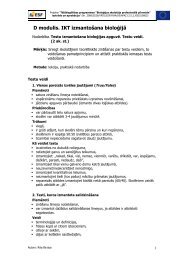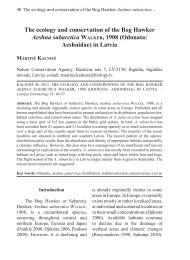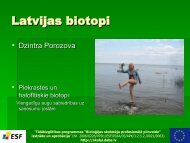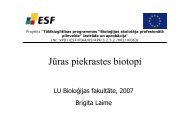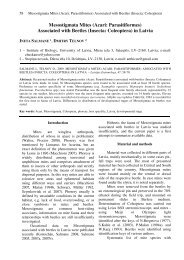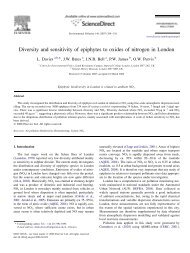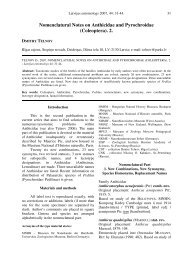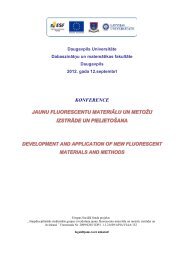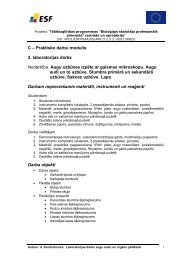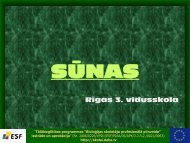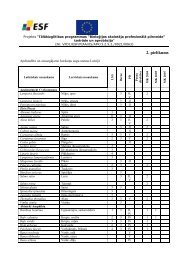Odonata - Entomological Society of Latvia - Latvijas Daba
Odonata - Entomological Society of Latvia - Latvijas Daba
Odonata - Entomological Society of Latvia - Latvijas Daba
Create successful ePaper yourself
Turn your PDF publications into a flip-book with our unique Google optimized e-Paper software.
decrease with the increase <strong>of</strong> those <strong>of</strong> Anax parthenope? Will the population <strong>of</strong> Leucorrhinia dubia<br />
decrease with the warming <strong>of</strong> the climate?<br />
Changes <strong>of</strong> species distribution The largest part (78 %) <strong>of</strong> the <strong>Latvia</strong>n dragonflies belongs<br />
to the Palearctic or West Palearctic type <strong>of</strong> current distribution. This is due to the fact that mainly<br />
species with very vast or vast areas <strong>of</strong> distribution in the Europe part <strong>of</strong> Eurasia are represented in<br />
<strong>Latvia</strong>n fauna. Four species (Pyrrhosoma nymphula, Aeshna cyanea, Brachytron pratense,<br />
Cordulegaster boltonii) are distributed mainly in Europe with some localities also in the northern<br />
part <strong>of</strong> Africa and the western part <strong>of</strong> Asia (Dijkstra 2006). Nevertheless, the distribution areas <strong>of</strong><br />
these species are quite vast. Mediterranean – Afrotropic species Anax ephippiger may be observed<br />
in <strong>Latvia</strong> due to the summer invasions <strong>of</strong> the species in the whole Europe (von Rintelen 1997; Ott<br />
2001), therefore this species may be considered only a guest species. Sympetrum fonscolombii is<br />
generally related to northern and central part <strong>of</strong> Africa region, south-western part <strong>of</strong> Asia and<br />
Mediterranean region. In northern regions the species can be found irregularly and rarely, but in the<br />
years <strong>of</strong> invasion it can be quite common (Dijkstra 2006).<br />
Data on dragonflies are available from whole territory <strong>of</strong> <strong>Latvia</strong> both in historical (1778-<br />
1990) and current (1991-2010) periods (Figure 3). This scope and dividing line are based mainly on<br />
several obstacles, associated with fact that in 1990 <strong>Latvia</strong> withdrew from USSR. These (political)<br />
changes generated consecutive changes in science (availability <strong>of</strong> information, publications,<br />
contacts with western scientists etc.), in agriculture (less chemicals, in the first years – development<br />
<strong>of</strong> small farms), in forestry (more and more active forestry) and social process (project activity,<br />
greater mobility <strong>of</strong> scientists) (CSP 2011). The same division is used in dragonfly Atlas <strong>of</strong> Poland<br />
(Bernard et al. 2009).<br />
Although the historical period is the longest, in this period the data were obtained about a<br />
smaller territory (13 % <strong>of</strong> all squares <strong>of</strong> <strong>Latvia</strong>) than in the current period (23 % <strong>of</strong> all squares <strong>of</strong><br />
<strong>Latvia</strong>). Nevertheless, the survey <strong>of</strong> <strong>Latvia</strong> has not been homogenous neither in the historical, nor<br />
the current period. The vicinity <strong>of</strong> Rīga and Sigulda has been surveyed more accurately, which is<br />
related to the places <strong>of</strong> work and residence <strong>of</strong> dragonfly researchers both in the historical and the<br />
current periods. Thoroughly surveyed are also some <strong>of</strong> the specially protected nature territories<br />
(Gauja National Park, Protected Landscape Area ‘Ziemeļgauja’, Teiči Nature Reserve etc.). The<br />
eastern part <strong>of</strong> <strong>Latvia</strong> and individual territories in Kurzeme and Zemgale have been only partially<br />
surveyed, which is due to the greater distances from the places <strong>of</strong> work and residence <strong>of</strong> dragonfly<br />
researchers, research centres and difficulties to reach these territories during the historical period.<br />
The number <strong>of</strong> identified species in one square is mainly related to the type <strong>of</strong> research<br />
activities. The largest number <strong>of</strong> species is identified in specially protected nature areas or in places,<br />
where the research was carried out longer, for example, the Engure lake, Gauja National Park<br />
(Спурис 1951; Inberga-Petrovska 2003; Kalniņš 2006; Kalniņš et al. 2007), in places where some<br />
projects or researches were carried out (Kalniņš 2002b; Mathes, Mathes 1997; ES LIFE... 2007) or<br />
near the places <strong>of</strong> work or residence <strong>of</strong> dragonfly researchers (Figure 17). The quantity and the<br />
quality <strong>of</strong> the observations were affected also by other aspects related to dragonfly research. Some<br />
species, for example, Calopteryx genus dragonflies are easier to observe and identify and they are<br />
<strong>of</strong>ten photographed. At the same time, other species are more difficult to observe, for example,<br />
Epitheca bimaculata (only imagines!!), or they are easily confused with other similar species<br />
(Coenagrion lunulatum). Some species are registered more <strong>of</strong>ten, as their flight period is longer and<br />
lasts several months in the summer. At the same time, the imago activity period for Coenagrion<br />
armatum is in spring, when dragonfly observations are not as intensive. Thus, when comparing the<br />
distribution <strong>of</strong> species with different imago activity periods, a faulty conclusion about the<br />
distribution <strong>of</strong> species may arise. Simultaneously, it must be taken into account that different<br />
habitats are not research to equal degree, for example, raised bog habitats were researched very<br />
little in the historical period. Perhaps, this is the reason why almost all Aeshna subarctica localities<br />
have been identified in the current period, as the surveying <strong>of</strong> bogs has become more intensive.<br />
Also the methods <strong>of</strong> dragonfly inventory affect the results. Since 2005, when the author started to<br />
collect Anisoptera exuviae, the number <strong>of</strong> Epitheca bimaculata localities has grown considerably.<br />
Another aspect is that the survey <strong>of</strong> squares has been carried out to various degrees (from 1-2<br />
observations <strong>of</strong> the species to several surveys throughout the season for several years). These and<br />
68



